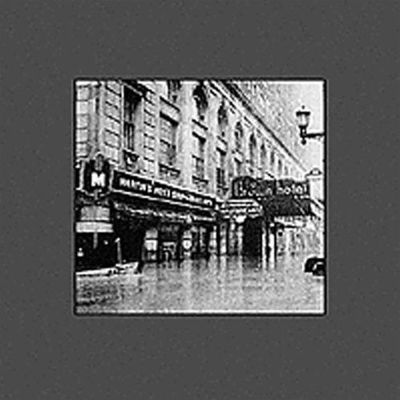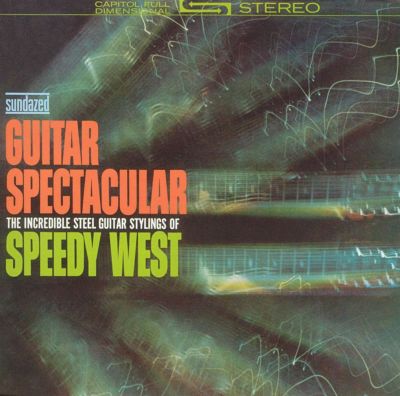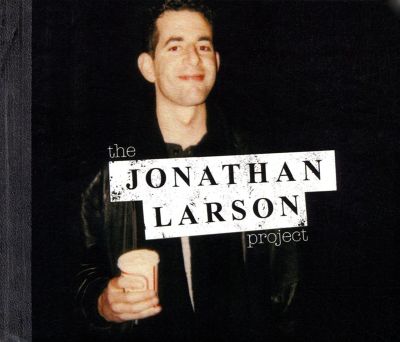Staff Picks for March 2022
March 31, 2022
A poetic improviser and stylistic iconoclast, trumpeter Ron Miles will be remembered for his warm sound and deeply considered approach to modern creative jazz. His atmospheric 1996 album Woman's Day found him delicately pushing the boundaries of the jazz tradition, as on a tribute to Nirvana frontman "Cobain," in which he wrapped himself in longtime collaborator Bill Frisell's shimmering guitar textures.
March 30, 2022
Slint member David Pajo's 1997 debut under the solo moniker Aerial M merged his slow-moving and obtusely angled approach to songwriting with the focus on texture that was happening in Chicago's post-rock circles in the late '90s. The entirely instrumental album is a cryptic roadmap of unexpected sounds, ambling through odd time signatures, bucolic guitar figures, blurts of spacy organ, and other subtle ambient touches.
March 29, 2022
Kris Bowers, Duomo, and the Vitamin String Quartet transform today's most popular tunes into quaint string covers, adding a Regency twist to songs like "Thank U, Next" and "Bad Guy." The soundtrack from the hit show skillfully bridges the past and present, as modern pop tracks become classical orchestrations perfect for ballroom dances and afternoon tea.
March 28, 2022
Coming off a four-year ascent that found him playing as a member of the Lionel Hampton band in 1953 to co-leading his innovative quartet with drummer Max Roach in 1954, Clifford Brown was a bona fide star by the mid-'50s and considered by many, including trumpeter Dizzy Gillespie, to be the best trumpeter of his generation. Tragically, Brown's career was cut short when he died in a car accident in 1956. Thankfully, Brown was well recorded before his death, and these sessions display both his adept gift for virtuosic improvisation and empathetic ear for subtle, tender accompaniment of vocalists.
March 27, 2022
Is this one of Korn's worst albums? Yes. But is it worth a revisit? Absolutely. Nestled amongst the dreck of their tumultuous 2000s era, this dark set features worthy cuts like "Hold On," "Ever Be," and "Love and Luxury," which find the band toying with their attack in ways that would reap more rewards in the 2010s. It's very much their bastard child, but diehards who need a break from the hits could find some gold within.
March 26, 2022
The songwriter's critical breakthrough was her first record to be written for guitar after a pair of piano-based school projects. Grungy, impulsive, and with memorably acerbic, vulnerable lyrics, it was the product of a particularly exhausting period that had her juggling college, work, and dating. She draws on tuneful alt-rock on tracks including the rebellious "Townie" while dropping graphic metaphors like, "I want a love that falls as fast as a body from the balcony." An auspicious if fatalistic label debut, it was produced by Patrick Hyland, who returned for her later commercial successes, including Top Five debut Laurel Hell.
March 25, 2022
With its rich and varied emotional moods and existential outcome, the full range of the composer's previous work was brought to bear on this 1959 work -- tension and release, danger and safety, movement and stillness, darkness and light; the textural palette that was Ellington's signature was always compellingly cinematic. In these orchestral settings, his soloists (Cat Anderson, Clark Terry, Johnny Hodges, and others) shine, as their playing reflects true variations on a theme in a classical sense. That's not to say that this set doesn't swing, too -- "Happy Anatomy" is a short but fully cranked gallop.
March 24, 2022
Nigo's first album is a relic of the era when Grand Royal and Mo Wax were the hippest labels around, and SPIN magazine was one of the most relevant voices in alternative culture. The album was internationally released on James Lavelle's imprint in 2000, and it features contributions from Cornelius, Ben Lee, Money Mark, and many others. It's all over the place, hopscotching from Japanese hip-hop to dub to mellow psych-pop to noisy punk, but the detached trip-hop splendor of "Too Much" is the best and most haunting cut overall.
March 23, 2022
Drawing from the 52 live appearances the Beatles made on the BBC between 1963 and 1965, this two hour collection captures the energy and fun of the band's early days. The band offers up electrifying performances of both originals and a slew of early rock and roll/beat tunes from their club repertoire, as well as the kind of humorous asides and interview styled clips that were customary for the BBC's pop programming at the time.
March 22, 2022
The far less glossy precursor to 1991's Fear, Toad the Wet Sprocket's more subdued second album is a textured and endearingly creative bit of classic college rock in the vein of early R.E.M.
March 21, 2022
While this stellar debut can't be considered a hidden gem in the least, it's worth remembering that a classic is a classic. Perfect from front to back, it's Garbage at its simplest, most no-frills, and absolutely potent. All the hits are here, but if you're looking for a moody '90s alt-rock time machine, "A Stroke of Luck," "As Heaven Is Wide," "Milk," and "My Lover's Box" are nostalgic food for the dark soul.
March 20, 2022
In his score for season one of Showtime's The Tudors, Trevor Morris fuses Renaissance and folk sounds with contemporary orchestral arrangements, creating a lavish soundtrack with dark and sinister undertones. The majestic yet ominous instrumentals are a fitting complement to the series' plot, which highlights the political intrigue and treacherous passions of King Henry VIII's reign.
March 19, 2022
Using little more than the sequencer of his vintage Roland SH-101 synth, the Montreal native builds a warm little house around his musings on aging, friendships, matters of the heart.
March 18, 2022
Lou Barlow’s album of breakup anthems hit incredibly hard as a teenager, and to an extent even more so as a middle-aged man. Bakesale may have evolved from the scrappy lo-fi recordings of the band’s earlier albums, but make no mistake that these tracks are still as raw and emotional as Sebadoh has ever been.
March 17, 2022
The MC5's second and final studio album, High Time comes closest to matching the energy and electricity of their live debut album. A much tighter album than you would expect by a band on the verge of breaking up. Saving the best for last, they toned down the politically charged rhetoric and kicked out the jams with a set of tight rockers, tender ballads, and jazz-influenced fusion.
March 16, 2022
After the breakup of Unrest, Mark Robinson and Bridget Cross teamed up again, now with drummer Gabriel Stout, to form Air Miami. Keeping with the sonic spirit of their previous band, the album features catchy tracks about having world cup fever, bodies of water, and their distaste for milk.
March 15, 2022
On Speedy West's final solo album, the pedal steel virtuoso blasts through a number of country and western romps, spends some time in orbit and on the moon (it was just after the Atomic Age after all), and lounges comfortably beachside. Of special note is the accordion work of Billy Liebert, a member of the Sons of the Pioneers who adds a rustic campfire flair to a number of the tracks.
March 14, 2022
Considered to be the album that cemented Madonna's megastar status, True Blue makes even those who weren't yet alive feel nostalgic for the 80s. With "La Isla Bonita"'s warm and tropical instrumentation, "Open Your Heart"'s passionate dance groove, and "Papa Don't Preach"'s courageous lyrics addressing teen pregnancy, True Blue simultaneously exhibits an exhilarating, carefree attitude and a serious, earnest perspective. Its songs have a hypnotizing effect that immediately entrances listeners, reminding us that while the '80s may be some decades behind us, its musical relics are still in great shape.
March 13, 2022
While their hit "Time of the Season" will get airplay on classic rock radio until the end of time, the rest of this album feels oddly unlike the work of so many of their contemporaries. Hints of Beach Boys harmonies feel oddly haunting coming from this brooding set of Brits, and the sighing Mellotron provides a compelling bed for the aching angst and sweet yearning of vocalist Colin Blunstone.
March 12, 2022
Recorded in 1974 at their final live show before a nearly two decade hiatus, Metallic KO hits all the expected marks for a late-era Iggy & the Stooges performance. Sloppy, chemical-assisted playing, Iggy baiting an already hostile audience into littering the stage with batteries, glass bottles, and anything else that would fly, and some amazing music not found on other Stooges releases until many years later.
March 11, 2022
Originally conceived as an Anna Waronker solo record, “Retreat From The Sun” transitioned that dog. from their previous fuzzed-out guitar sound to a more polished, mature, California pop vibe while still embracing the heartache of the band’s previous releases.
March 10, 2022
Melanie is mostly remembered for the hippie-ish naivete of her earliest work and the Junior High sexual metaphor of "Brand New Key." It's a shame, because she also penned some harrowingly personal, deeply felt music that would be celebrated by hipsters if it came from an obscure private-press artist. This collection leans to her most popular tunes, but offers enough deep cuts to demonstrate why her music matters.
March 9, 2022
Trombonist Joe Bowie's free-wheeling Defunkt outfit defy categorization. They rip through soul, funk, free jazz, rock, and blues, stretching the limits of each. The atmosphere is feverish; they don't do anything in an easy or simple manner. While not everything they try works, none of it is ever dull.
March 8, 2022
Orient captures the nomadic Don Cherry in a pair of live sets from the early '70s with different trios: One including the great Dutch drummer Han Bennink, the other with the amazing South African bassist Johnny Dyani. Cherry fans will recognize several themes here, including the very beautiful "Desireless" from Relativity Suite. Iit's fascinating to hear him work in material from Indian scales to township dance music to Herbie Hancock's "Maiden Voyage."
March 7, 2022
In their 1980s heyday, SST Records had a handful of acts who puzzled folks expecting punk rock, none more so than Saccharine Trust. While they could be noisy and angular, their heart was in free jazz as much as rock, and 1986's We Became Snakes was a fearlessly experimental exercise in boundary-spanning soloing from guitarist Biaza and sax player Steve Moss, playing off beat-influenced lyrics from vocalist Jack Brewer.
March 6, 2022
The group's most immediately accessible album eschewed the pattern of prior Heads albums, in which instrumental tracks were worked up from riffs and grooves, later adding improvised melodies and lyrics. Instead, the songs here, most of which were credited to Byrne alone (with the band credited only with arrangements), sounded like they'd been written as songs. The result: a double-platinum pop album that retained their charm and inventiveness.
March 5, 2022
Various Artists
Those discovering or rediscovering the Rent composer since the release of the film adaptation of his only other produced musical, tick, tick…BOOM!, may be interested in this 2019 tribute collection. With a runtime of over an hour, it includes not only previously unrecorded songs, rarities, and various other covers lovingly performed by Broadway alum (including Nick Blaemire and George Salazar from the off-Broadway tick, tick...BOOM!) but a demo performed by Larson himself.
March 4, 2022
Covering the four Metamatics EPs released on Clear during early 1997, A Metamatics Production charts the duo's course across abstract drum'n'bass and polar electro soundscapes. Equally comfortable working with breaks as with a four-four beat, Metamatics' sublime Detroit shadings and crisp percussion makes Kirk Degiorgio's As One project its closest precursor. The sublime electro update "Dope for the Robot" is the highlight.
March 3, 2022
The altoist capped his '70s return to Impulse! by diverting with the serene and colorful Vista, one of his least avant dates. While Brown wrote only the blissful coaster "Vista" itself, the five other compositions are well-chosen, starting with an inviting version of Stanley Cowell's "Maimoun" and an impressionistic and deeply meditative take on Stevie Wonder's "Visions." The second side is notable most for Harold Budd's placid "Bismillahi 'Rrahmani 'Rrahim," with Brown wafting softly over three discreet keyboardists including the composer on celeste.
March 2, 2022
Before "At Seventeen" revived her career in 1975, Janis Ian had a rather unusual career trajectory – a hit single at fifteen, dropped from her record deal after four albums by eighteen. Society's Child – The Verve Recordings collects those early albums in full, and if her songs sometimes stumble into youthful pretentiousness, they also reflect a precocious intelligence and emotional literacy that would do many thirty-something tunesmiths proud.
March 1, 2022
Inspired by director Andrei Tarkovsky's atmospheric masterpiece Stalker, Robert Rich and Lustmord's album of the same name is an acknowledged dark ambient classic in its own right. Clearly taking cues from Edward Artemiev's mesmerizing electro-acoustic score, the album drifts off into its own haunted realm, pairing ominous synths with displaced thumps and obscured voices. Like the movie, this is an immersive work which rewards devoted attention.






![Anatomy of a Murder [Original Motion Picture Soundtrack]](https://fastly-s3.allmusic.com/release/mr0001348331/front/400/W2DJwpbzymQIh42HH2DXnZhUoDg0hsvx4F4sL4oO-nA=.jpg)




![The Tudors [Original Television Soundtrack]](https://fastly-s3.allmusic.com/release/mr0000599777/front/400/z5IU6L55Ttk1w7Ci2yWDSFWnbEN5fCjifro6xhIBuB4=.jpg)


















